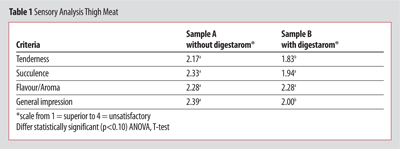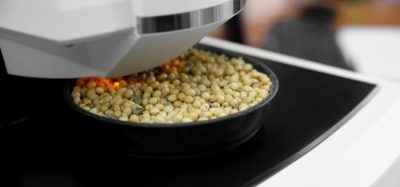Can the sensory quality of chicken meat be improved?
- Like
- Digg
- Del
- Tumblr
- VKontakte
- Buffer
- Love This
- Odnoklassniki
- Meneame
- Blogger
- Amazon
- Yahoo Mail
- Gmail
- AOL
- Newsvine
- HackerNews
- Evernote
- MySpace
- Mail.ru
- Viadeo
- Line
- Comments
- Yummly
- SMS
- Viber
- Telegram
- Subscribe
- Skype
- Facebook Messenger
- Kakao
- LiveJournal
- Yammer
- Edgar
- Fintel
- Mix
- Instapaper
- Copy Link
Posted: 12 May 2010 | Renate Thieme and Steve Ladbrook, MICRO-PLUS GmbH | No comments yet
The digestarom poultry concept has been proven worldwide to advantageously influence the performance parameters and, therefore, the profitability of chicken meat production. Small scale institute evaluations have demonstrated improvements to carcass composition and this information is available. It was this latter finding that led to professional taste panel studies on the sensory quality of chicken meat.
The digestarom poultry concept has been proven worldwide to advantageously influence the performance parameters and, therefore, the profitability of chicken meat production. Small scale institute evaluations have demonstrated improvements to carcass composition and this information is available. It was this latter finding that led to professional taste panel studies on the sensory quality of chicken meat.
The digestarom poultry concept has been proven worldwide to advantageously influence the performance parameters and, therefore, the profitability of chicken meat production. Small scale institute evaluations have demonstrated improvements to carcass composition and this information is available. It was this latter finding that led to professional taste panel studies on the sensory quality of chicken meat.
In conjunction with the Georg-August- University in Gottingen, Germany, a professional taste panel has performed trials to evaluate the sensory quality of broiler thigh and breast meat.
In order to perform the sensory analysis, 120 as-hatched Ross 308 birds were randomly divided into a control group and treatment group. Needless to say, the only difference in the diets was the inclusion of the phytogenic feed additive in the treatment group, all other ingredients were exactly the same. After a 32 day period, 50 birds from each group were randomly chosen to conduct the sensory analysis. At 32 days, the control group weighed on average 1562 gms and the treatment group 1610 gms. The carcass yield increased in the treatment group to 75.2 per cent, with the control at 74.6 per cent. The evaluation was on the thigh meat which was grilled at 180°C and served to an 18 member trained taste panel. Table 1 (page opposite) shows the results. The tenderness and general impression were significantly enhanced in the treatment group, with a strong tendency to more succulent meat.
In a second similar study at this university, carried out at a different time with the same genotype broilers, the meat was again grilled at 180°C with the cooking time adjusted by using a core probe to 70°C. A trained taste panel assessed 56 pieces of breast meat. A hot air cooker type LAINOX Heart with Interactive Cooking System and core probe was used. After cooking, each piece of breast meat was sliced into three equal parts and placed on a paper tray (see Figures 1 and 2). In order to avoid mistakes and to be able to trace each piece of meat back to the original bird, the position of each piece on the grill and the grill in the cooker was recorded. The paper trays were marked with numbers usually used for triangle tests (like 22-24-26). With the three pieces from each sample of meat, two triangles were built using two pieces as a double sample in one triangle and the remaining piece as a single sample. The test person had, of course, not known what the triangle contained and 14 people were totally independently involved in the taste panel. In order to simplify the procedure and to standardise, for statistical analysis, the description was given as more juicy, less juicy, tender or harder. Special notes could also be made. Therefore, it was possible to control if the answer was correct. In total, four triangles were tested, with always a short break in between, from 9.30 am to 11.30 am.
In the first and second triangle test, four incorrect and 10 correct answers were recorded. The next test resulted in seven to seven with the fourth triangle giving five incorrect and nine correct answers. The breast meat from the digestarom group was recognised 36 times as juicer or more tender than that from the control group. For a total of 20 times, the answers were incorrect or insufficient (statistically significant 0.001).
To obtain additional information, the other portions of breast meat from the above evaluation were sent to FOOD GmbH in Jena, an accredited laboratory, to analyse for the content of intramuscular fat. In the samples of the control group, an average of 1.17 per cent intramuscular fat was detected. In the samples from the digestarom treatment group an average of 1.25 per cent was found. Although the difference was not statistically significant, there was a clear indication of a higher level of fat in the treated samples. The standard deviation for the control group was 0.4405 and that for the treatment group 0.3123. It is well known that the taste of meat is influenced by the level of intramuscular fat and its consistency.
A trial was conducted in the UK at an independent sensory evaluation unit to benchmark the eating quality of chickens with digestarom in the feed with two other sources of chicken. The chickens were randomly selected from supermarket shelves. The breast meat from whole roast chickens was assessed subjectively for acceptability of aroma, flavour, texture and aftertaste on a scale of one (extremely acceptable) to eight (extremely unacceptable). The panellists were also asked to make an objective assessment of all the characteristics on a scale 0-100. The results showed a general taste preference for the chickens with digestarom in all aspects, i.e., aroma, flavour, texture and aftertaste.
In all these studies on chicken thigh and breast meat, the use of digestarom in the feed positively changed the sensory quality in the direction of juicier and more tender. Research has shown that consumers prefer more succulent and tender meat. It is believed that these studies with a digestive enhancer are unique. They provide added value to the use of digestarom poultry.











